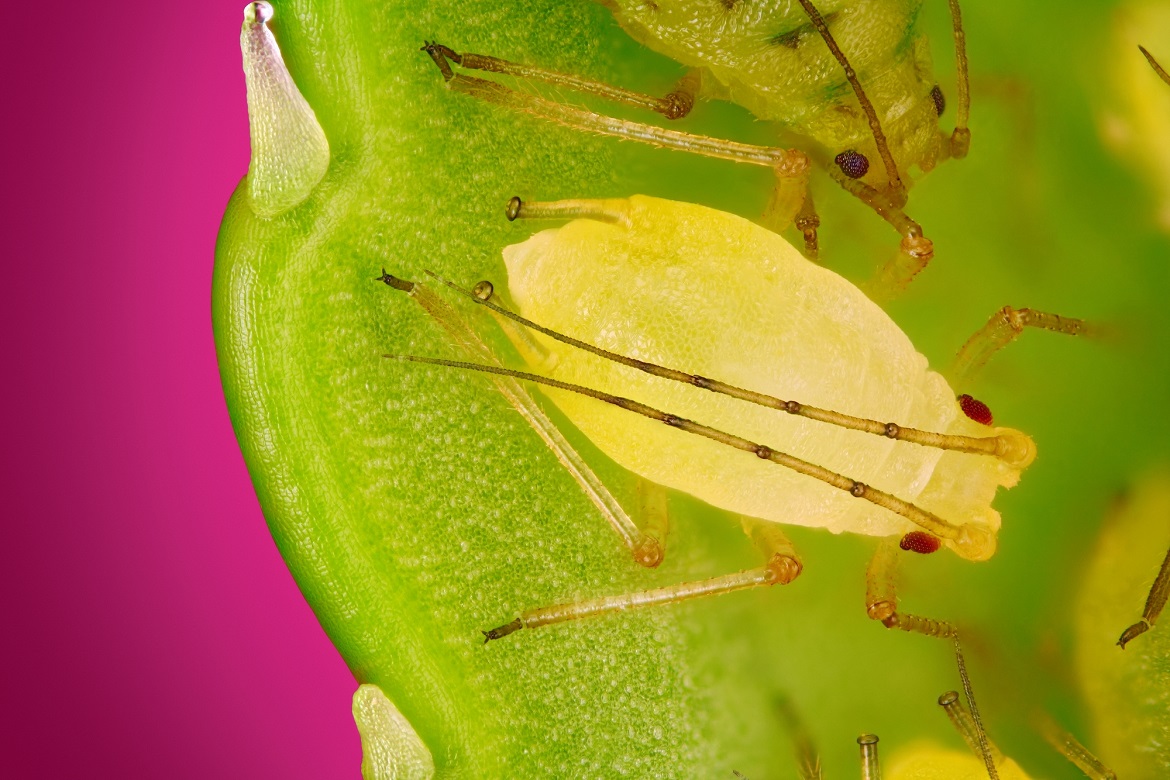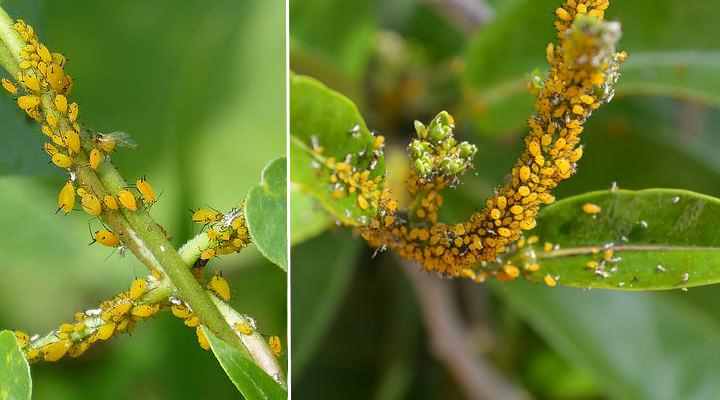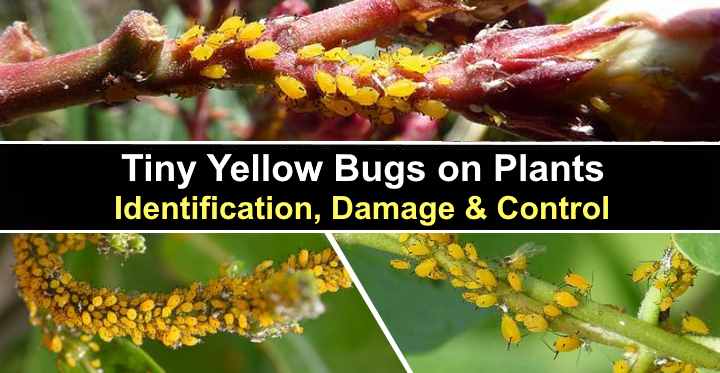Discovering a swarm of small, yellow insects with black legs and antennae on your indoor or outdoor plants can be alarming. These tiny creatures are commonly known as yellow aphids and are a type of sap-sucking insect that feed on the sap of plants. They can cause significant damage to your houseplants and other decorative plants.
To get rid of yellow aphids, it’s important to identify them properly. Yellow aphids are small, pear-shaped insects with yellow bodies and black legs and antennae. They tend to gather in large numbers on the leaves and trunks of plants, making them easy to spot.
If you find yellow aphids on your plants, there are several ways to eliminate them. One effective method is to spray the plants with a solution of soapy water, which suffocates the aphids and kills them. Another option is to use neem oil, which is a natural insecticide that repels aphids and other pests.
To prevent yellow aphids from infesting your plants in the future, it’s essential to keep your plants healthy and well-maintained. Regularly inspect your plants for signs of infestation and prune away any heavily infested leaves or branches.
By taking these steps and being vigilant, you can protect your houseplants and decorative plants from the damage caused by yellow aphids.
What Are Yellow Bugs on Plants?

Soft-bodied yellow insects known as yellow aphids (Aphis nerii) have infested many areas worldwide, particularly in tropical and subtropical regions. These insects are also known as oleander aphids, sweet pepper aphids, and milkweed aphids. When they bite into the leaves and stems of plants, these tiny creatures suck juices from the plant tissue, and they can also spread diseases.
What Do Yellow Bugs (Aphis nerii) Look Like?

The lemon-yellow pear-shaped bodies, long black legs, dark antennae, and two small black tubes at the rear end, known as cornicles, are all visible features of yellow aphid bugs on plants. These tiny insects use their long and slender mouthparts to penetrate and suck the juice from the leaves, stems, and other soft parts of the plant. Some yellow aphids may also have a woolly appearance.
Another distinguishing feature of adult female yellow aphids is their black wings. These, along with their black legs and antennae, give them their yellow and black appearance. As the colony of yellow aphids grows too large, the winged bugs may fly to other plants.

The yellow aphids, also known as Aphis nerii, are tiny insects that are only 0.06″ to 0.1″ (1.5 to 2.6 mm) long. These winged female aphids are usually found in clusters on plant leaves and stems.
The bright yellow color of these tiny insects makes them quite noticeable. You can easily identify them by their black legs, antennae, and cornicles, which are small tubes at the back of their bodies. However, if you use a magnifying glass, you can see them as tiny yellow dots on the leaves.
Yellow Aphid Life Cycle

The yellow aphid life cycle begins when a female gives birth to live nymphs instead of laying eggs. The nymphs undergo five developmental stages or instars before reaching adulthood. At each stage, they molt or shed their skin, and once fully grown, they become adults capable of reproducing. Female aphids can deposit up to 12 nymphs per day.
In some yellow aphid species, mating and egg production occur in the fall or winter. The eggs can be deposited on perennial plants, overwinter, and hatch the following spring. Under warm conditions, a nymph yellow aphid can mature in just eight days and produce up to 80 offspring every week. This rapid reproduction rate makes the yellow aphid a pest to plants.
Where Do Yellow Bugs Come From?

Yellow aphids can survive during winter by hiding under leaves or in tree bark cracks. They come out of hiding when the weather warms up. Furthermore, yellow aphid eggs can enter houses when infested houseplants or soil are brought indoors. These pests can also fly in through open windows.
Aphids can travel from neighboring plants or trees in warm southern gardens or be carried by the wind. To prevent yellow aphid infestations, it is a good idea to carefully inspect new plants for signs of aphids or bug damage, as these tiny insects can easily hitch a ride on houseplants. Look for small yellow mites moving under leaves or tiny whitish eggs the size of pinheads.
It is also a good practice to repot newly acquired houseplants to ensure that the soil is not contaminated with yellow aphid eggs or nymphs. Finally, make sure to remove old soil from your home or yard to prevent the spread of these pests to other plants.
How to Identify Yellow Bugs (Yellow Aphids) on Plants
When it comes to identifying yellow bugs on plants, there are two ways to go about it. One is to look for visible signs of yellow, pear-shaped insects on the leaves, while the other is to look for signs of plant damage. If you notice plants with deformed leaves that are curled or slow plant growth, you should inspect the foliage for yellow bugs.
Tiny yellow bugs may also be seen scurrying around under leaves. Additionally, yellow insects often leave behind a sticky substance called honeydew, which can cause plant leaves to look bent or deformed. If you want to identify yellow aphids, you’ll need to use a magnifying lens to spot the following identifiable bug features:
- Long black legs and a bright lemon-yellow pear-shaped bug
- Two large antennae and two black cornicles at the back of their head
- The black wings of many adult yellow aphids are clearly visible.
Plant damage is the other distinguishing characteristic of yellow bugs, and it’s the most obvious. You should inspect the foliage for yellow bugs if you notice plants with deformed leaves that are curled or slow plant growth. Honeydew, a gooey, amber-colored material, is commonly an indication of aphid activity as well.
Signs of Yellow Bug Plant Damage
Yellow aphids can cause damage to plants in several ways. They can cause the foliage of the plant to turn yellow, stunt its growth, and leave a sticky residue known as honeydew. The honeydew can attract ants and other insects, which can cause further damage to the plant. Additionally, the honeydew can promote the growth of sooty mold fungus on the leaves, which can further harm the plant.
In large numbers, yellow aphids can significantly damage plants, making them more susceptible to diseases and other stresses. This is because the insects feed on the plant’s sap, which contains essential nutrients. When the aphids feed on plants, they can also transmit viruses, which can cause further damage. While small numbers of yellow aphids may not cause much harm, it is essential to keep an eye on them and take action if the infestation becomes severe.
How to Get Rid of Yellow Bugs on Plants
To eliminate yellow bugs on plants, it is essential to use a combination of methods. The first step is to physically remove the yellow plant bugs from the plant. You can gently shake the plant or spray it with a strong stream of water to dislodge the insects. Additionally, you can use sticky traps or insecticidal soap to catch and kill yellow aphids.
Natural plant bug sprays like neem oil are also effective in getting rid of yellow aphids. These products contain natural ingredients that repel and kill the bugs, including their eggs and larvae. Regular application of the plant bug sprays is necessary to ensure that the infestation is eradicated.
In addition to physical and chemical methods, it is also crucial to maintain the health of the plant. Healthy plants are less vulnerable to yellow bug infestations. Proper watering, fertilization, and pruning of the plant can help keep it healthy and less susceptible to pests.
Eliminate Yellow Bugs Using Water Pressure
A practical method for eliminating yellow bugs from plants is by using water. Spraying them with water can effectively dislodge the insects from leaves and stems. This technique is applicable for both indoor and outdoor plants. To remove yellow bugs from an infested houseplant, one may use a strong water spray before bringing it to the shower. The insects will be washed away, while the plant’s leaves will be hydrated, promoting its overall health.
For outdoor plants, a garden hose with a strong spray can be used to blast aphids with water. Care should be taken to avoid damaging the foliage while ensuring that the spray is strong enough to dislodge the bugs. It is also essential to target the undersides of leaves where aphids may be hiding.
To prevent fungal infections, it is advisable to spray the water early in the day, allowing the foliage to dry before the evening. This method is a non-toxic and eco-friendly solution for getting rid of yellow bugs on plants.
Use a Neem Oil Spray to Kill Yellow Bugs on Plants
To get rid of yellow aphids on plants, neem oil can be used as a natural and organic insecticide. To make a spray, mix 1 tsp of neem oil in 1 quart of lukewarm water with 2 tsp of dish soap. This solution can be sprayed on the infected plant’s leaves thoroughly. Applying the neem oil spray every seven days can effectively control and kill yellow aphids.
Azadirachtin is the active ingredient in neem oil, which acts as an insect repellent and disrupts the reproductive system of insects, including yellow aphids. Using neem oil can help protect your plants from the invasion of yellow bugs by killing them.
According to scientific research, spraying plants with neem oil can help eliminate yellow aphids and protect them from damage. One study found that aphids tend to avoid eating plants treated with neem oil solution. Additionally, neem oil spray can also harm Aphis nerii, the yellow bug species.
Insecticidal Soap to Eradicate Yellow Bugs on Houseplants
To eliminate yellow bugs effectively, you can use insecticidal soap spray that is readily available in the market. Alternatively, you can make your own bug spray by combining baking soda with water and liquid Castile soap with distilled water and vegetable oil. This solution is then sprayed onto the leaves of the infected plants using a pump sprayer or a handheld spray bottle.
The fatty acids present in the soap solution dissolve the yellow bug’s soft bodies, killing them permanently. The use of organic insecticidal soap sprays helps to preserve the plant’s health while effectively eliminating the bugs that are causing damage to it. It is a safe and efficient way to get rid of yellow bugs on plants.
Apply Rubbing Alcohol to Kill Yellow Aphids Instantly
Yellow bugs can be quickly killed by using a 70% rubbing alcohol solution. You can make an isopropyl alcohol bug spray by combining one cup of isopropyl alcohol with one quart (1 L) of water. After that, you should spray the solution on the yellow bugs present on your plants. To get the best results, weekly alcohol spraying is recommended to kill yellow aphids and other houseplant pests.
Moreover, an alcohol bug spray can kill aphid eggs that overwinter on plant leaves. In the spring, you can dip a cloth in the alcohol-water solution and wipe down both sides of the leaves and around the stems to prevent an outbreak of yellow bugs. Lastly, this method can also kill any microscopic aphid eggs that may be hidden.
Sprinkle Diatomaceous Earth to Kill Yellow Pests on Plants
Non-toxic diatomaceous earth (DE) can be used to eradicate yellow aphids by dusting plant leaves with the white powder. The abrasive substance dissolves the waxy coating on their bodies, causing the insects to dehydrate and die. Here are a few things to keep in mind when using diatomaceous earth as a bugicide:
- Make sure to use food-grade DE, as it is safe to use around plants, pets, and humans.
- Use a dust mask to avoid inhaling the fine powder.
- Apply DE to the top and underside of leaves, as well as around the stem.
- Reapply the dust after heavy rain or watering, as the powder will wash away.
- DE can be harmful to beneficial insects, so avoid applying it during pollination periods.
- Monitor the plant for yellow bug activity after applying DE, and reapply as needed.
Control Yellow Bugs Indoors Using Sticky Traps
You can use yellow or blue sticky traps to control yellow aphids on your plants. These traps are effective in catching various flying plant pests, including the pesky yellow flying bugs. Although they may not entirely eliminate yellow aphid populations, sticky traps can certainly help.
Introduce Beneficial Insects for Yellow Bug Control
In your greenhouse or garden, are yellow insects causing havoc on plants, shrubs, and trees? Introducing beneficial insects may help eliminate aphids naturally if that is the case. The plant-destroying bugs are hunted down and killed by natural predatory aphid enemies, thus they no longer pose a threat to plant health.
Parasitic wasps are the greatest beneficial insects to promote in your yard or greenhouse. The nasty yellow insects are killed from the inside by these flying creatures, which lay eggs inside them. When you start to notice mummified aphids on plants, you know that the parasitic wasps are working.
You can also use the following kinds of beneficial insects to control aphids:
- Ladybugs: These small beetles feed on aphids and other soft-bodied insects, making them an effective natural control method.
- Lacewings: These delicate insects have a voracious appetite for aphids and can eat up to 200 per week.
- Hoverflies: The larvae of these flies consume aphids and other soft-bodied insects, making them an effective natural predator.
- Minute pirate bugs: These tiny bugs are a natural predator of aphids, and they can eat up to 80 aphids per day.
How to Prevent Yellow Bugs on Plants
Preventing little yellow bugs from invading your houseplants or outdoor plants can be challenging. The best strategy for bug prevention is to grow robust plants that are resistant to all types of plant pests, especially yellow aphids. Additionally, keeping plants healthy and pest-resistant involves watering them correctly and using the right fertilizer.
On preventing a yellow bug infestation on your plants, here are a few helpful tips
Inspect new houseplants for bugs
Whether they are from a garden center or your patio, always inspect houseplants when you bring them into the home. Bugs can infect plants that are growing outside. Little yellow insects like to hide under leaves as a hiding spot. Before bringing them inside, examine them with a magnifying glass.
Wipe plant foliage
Wiping down the foliage with an ethanol solution is a effective plant bug prevention method. Any aphid eggs found on plant leaves are killed by this simple yet efficient technique. In the spring, you’ll be able to keep yellow aphids from hatching.
Get rid of ants from the garden
Controlling yellow aphids requires the elimination of ants from garden plants. Since aphids feed on honeydew given by the aphids, ants defend them from predators. Beneficial predatory insects may find it difficult to get rid of aphids. Get rid of the ants as well to increase your chances of getting rid of yellow bugs.
Avoid overfertilization to prevent yellow bugs on garden plants
Always apply the correct amounts of fertilizer to your beautiful garden shrubs to avoid attracting aphids. Nitrogen levels in the soil increase aphid reproduction. Slow-release or organic fertilizers are the best way to fertilize your garden plants.
Use reflective mulch covers to prevent yellow bugs on outdoor plants
To avoid a yellow aphid infestation in your plants, you can use reflective mulch cover around crops and ornamental shrubs. According to some studies, reflective mulches act as a repellent for aphids and aid in the protection of crops from infestation and aphid-transmitted diseases.
Avoid using broad-spectrum pesticides on outdoor plants
If you are trying to get rid of yellow insects from your lawn, it is best to avoid using broad-spectrum pesticides. These types of pesticides not only kill the harmful insects but also the beneficial predatory insects.
